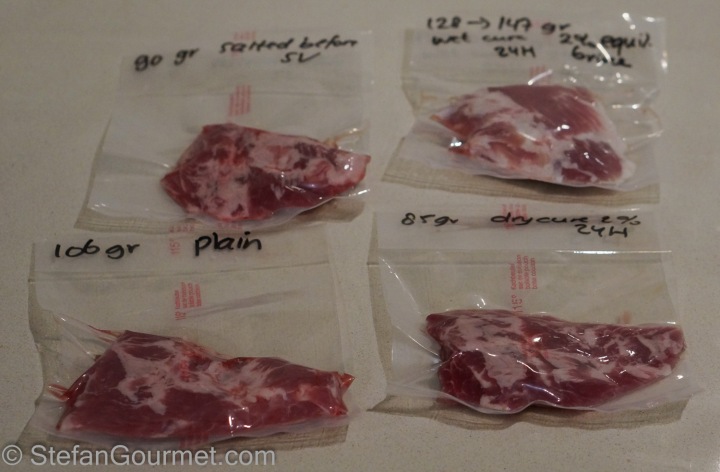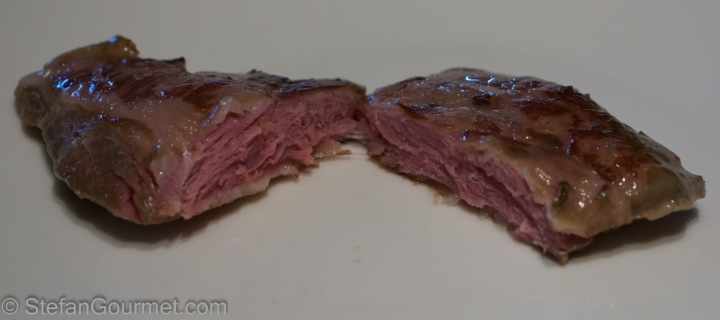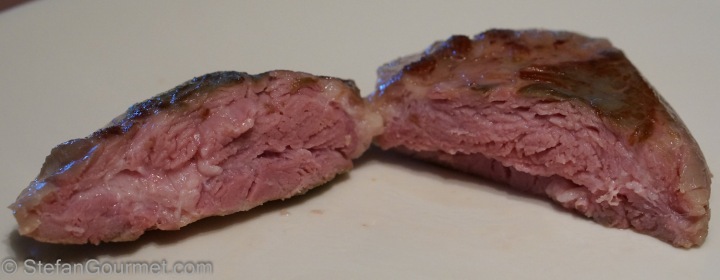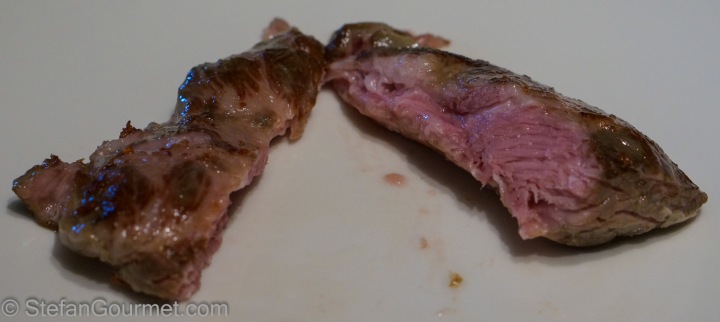Tougher cuts of meat can be cooked sous-vide for a long time (1 to 3 days) to render them tender and keep them juicy at the same time. I’ve been cooking sous-vide for over three years, and I’ve usually salted meat right before vacuum sealing it to be cooked sous-vide. I have however also seen recipes that salt the meat after cooking sous-vide, or recipes that brine the meat first. I’ve even seen recipes that dry cure meat first (i.e. add salt and vacuum seal, then wait for 24 hours, then cook sous-vide), and wondered whether that would make any difference as the time needed to cook the meat sous-vide would certainly be sufficient to allow the salt to penetrate all the way to the core of the meat. Would it make a difference to allow the salt to penetrate the meat before cooking, or not? As none of the recipes explain these differences, there was only one way to find out: a side-by-side experiment!

For this experiment I picked up a nice piece of iberico pork, the pluma (feather) of the loin. The pluma is the cut that is joined to the the loin at the bottom end, the equivalent to the flank. Like all iberico pork, it is very nicely marbled.

I cut the iberico pork into four roughly equal pieces, weighed them, and treated them as follows:
- Piece #1 I just vacuum sealed and labeled it “Salted before SV”. Its starting weight was 90 grams.
- Piece #2 I salted with 2% salt by weight, vacuum sealed it, and labeled it “Dry cure”. Its starting weight was 85 grams.
- Piece #3 I combined with water and 2% salt by total weight, vacuum sealed it, and labeled it “Wet cure”. Its starting weight was 128 grams (before adding the water).
- Piece #4 I a just vacuum sealed and labeled it “plain”. Its starting weight was 106 grams.
I then refrigerated all four pieces for 24 hours.

After those 24 hours, I took all four pieces out of their vacuum baggies. I did this to treat them all as equally as possible. Then I did the following:
- I salted piece #1 (“Salted before SV”), and vacuum sealed it.
- I vacuum sealed piece #2 (“Dry cure”).
- I discarded the brine of piece #3, weighed it, and vacuum sealed it (“Wet cure”). Its weight had increased from 128 to 147 grams (+15%) from absorbing the brine.
- I vacuum sealed piece #4 (“Plain”).

Then I put all four pieces in the sous-vide cooker…

…and cooked them sous-vide for 24 hours at 55ºC/131ºF. This time and temperature was a bit of an educated guess (shorter and lower than iberico secreto) and turned out great. The meat was tender and juicy and still had a nice ‘bite’ to it.

It was now time to taste them all, starting with #1.

I patted each piece dry with paper towels…

…and browned it quickly over high heat in clarified butter.

Piece #1, salted just before cooking it sous-vide, had lost 10% of its weight. The meat was equally salted throughout, tasty, tender, and juicy.

Piece #2, salted 24 hours before cooking it sous-vide and thus “dry cured”, had lost 7% of its weight. I think it had lost slightly less weight than piece #1 because I used more salt on this one. In hindsight, I should have used 2% salt by weight on piece #1 as well rather than just eyeballing the amount of salt. Although the slightly lower weight loss than piece #1 indicated that it was more juicy, we couldn’t notice a difference except that piece #2 was more salty. Perhaps I should repeat the experiment more carefully, but my tentative conclusion is that salting 24 hours before cooking sous-vide or salting right before cooking sous-vide doesn’t make a significant difference (if you use the same amount of salt).

Piece #3 was wet cured and lost only 4% of its original weight. (It went up from 128 grams to 143, and then down to 123.) So all of the added liquid from the brine was gone, but it still ended up losing less liquid than the others. We thought that this piece had a slightly better texture and was slightly more juicy than the other pieces, but this difference was very small. (You can actually see in the photo that the texture is a bit different.) I also thought that perhaps it tasted slightly less porky, but that may have been my imagination. (This could be caused by some of the pork juices being replaced by the brine.)

Finally, piece #4 was salted only after pan-searing it. It lost 12% of its original weight. This indicates that salting before cooking sous-vide is a good idea because it reduces loss of juices. We did not however notice a significant difference in texture or juiciness compared with pieces #1 and #2. What was quite difference of course was that the salt was only on the outside and not inside the meat. You may or you may not prefer this.
Conclusion
The differences between these four pieces were very small. All of them were delicious. My main conclusion is that salting before cooking sous-vide is a good idea, as it seems to help reduce the loss of meat juices during cooking and allows the salt to penetrate deeply into the meat.
Brining seems to be an interesting option before cooking sous-vide, although I am not sure that the extra step and waiting time is worth it. I’ll have to do another experiment with a proper brine, i.e. with not just salt in the brine but also sugar. I left out the sugar in this experiment to make it a fair comparison between the four pieces.
Flashback

Two years ago I blogged about penne with bell peppers and salami, as quick and pasta dish that I prepare quite often. I have started adding a tablespoon or so of heavy cream to this to take the acidic edge off, as the combination of tomatoes, salami, and wine can turn the dish a bit acidic.



Very interesting! As I’ve not always done this, I will now make sure to salt the meat first. Thanks!
LikeLike
It would be interesting to add a #5—Dry Brine (8 hours, naked in the fridge pre-SV)—specimen to the experiment.
LikeLike
A really interesting scenario!
LikeLike
Very interesting Stefan. I do think from random cooking experiments and from reading various sources that it also matters the cut of meat you are using as well as type of animal. For cuts of beef for instance that are already tender and only need to be cooked to temp, salting too long before cooking gave me a texture that is not very pleasant. These were more cured and had a texture similar to ham…a bit dense. So for items like ribeyes, strip steak, fillet,….I always salt right before searing. However, for items that require longer cook times especially pork (shoulder, ribs), salting and then packaging and cooking SV gave me a desirable end result.
LikeLike
I’ve never had a ‘ham’ or ‘cured’ style result, and I almost always salt everything before vacuum sealing. Perhaps this is because I only use a bit of salt. I like it when the meat is lightly salted all the way through, not just on the surface.
LikeLike
Hallo Stefan, danke dass Du Dir so viel Mühe machst!
Die Ergebnisse sind sehr interessant!
Aber nicht wirklich überraschend.
LikeLike
Hi, thanks for visiting and taking the time to leave a comment. You are right that these findings were not very surprising. Sometimes it is worth to confirm what you already expected.
LikeLike
Sprinkling your cut of meat with salt (and whatever else) before vacuum sealing and then dunking into your water bath seems to be the way to go, anything else is too many extra steps with no real benefit. Many people say care is needed when adding spices pre-vaccing because they say SV amplifies those flavours but I have yet to experience that myself and the science seems questionable.
LikeLike
Hi Simon, thanks for visiting and taking the time to comment. I agree with you that adding spices with sous-vide cooking seems to work just fine. From a scientific point of view it makes sense to use less spices when the cooking time is long (some sous-vide braising I do is 48-72 hours), so the spices have more time to give off their flavor.
LikeLike
Hi Stefan.
I’m very happy reading your comparison experiments. It makes it so much easier for the rest of us, to decide what the best method to use is. It’s a great help.
I have been very reluctant to salt meat, that would be cooked for a long time, being afraid that the salt would drive out liquid from the meat.
I often use 8% salt and 4% sugar brine, adding various spices, for these cooking projects, and that seem to work fine for me.
LikeLike
Hi, thanks for visiting and taking the time to leave a comment.
It is true that the salt with initially draw liquid out of the meat, but then a lot of that liquid will be absorbed again. When cooked for a long time it doesn’t really make a difference how long, as after a while an equilibrium is reached and the distribution of salt won’t change anymore from then on.
The brine you use is quite salty, so you have to be careful not to leave in the meat too long. I prefer to use an equilibrium brine, because there is no risk of over salting.
Your blog looks very interesting, but I’ll have to use Google Translate it on it as my Danish (or is it Norwegian?) is not good enough.
LikeLike
Hi. I had to look up equilibrium brine, I have never tried that, but i will try it the next time, though it will prolong the prep time with ½ to 1 day.
My blog is in danish because I more or less started out writing for my own sake to keep track of what I had done and how it turned out. I didn’t think it in a global context, On the other hand I really value all the people blogging about food preparation. It is a great source of inspiration and knowledge
LikeLike
I enjoyed your experiment! I don’t have a sous-vide cooker but it’s always interesting to read about it.
LikeLike
Reblogged this on Recipes For You 2013 and commented:
Interesting way of preserving meat..salting it
LikeLike
Hey Stefan, thanks for sharing all of your experiments. I know this is an old post, but I am attempting a 72 hour beef rib sous vide right now. I lightly salted my meat for a few hours (dry brined) before vacuum sealing and cooking sous vide, 133 F. I did the boiling water blanch for 30 seconds after vacuum seal too to kill the lactobacillus.
My only concern in retrospect is the salting. I am afraid of the salt curing effects that some people warn about. Do you get this effect at all?
Makes sense to dry brine before cooking sous vide at the higher temps, or cooking conventionally. But will dry brining cause a curing effect when sous viding at low temps?
Also, unfortunately, I was only able to purchase deboned beef ribs that are sort of thin. Maybe about 2 inches and tapers down to about .5 inches. I would have preferred to use thicker pieces. Is this going to be a problem?
LikeLike
Hi Paul, in my experience you do get a curing effect from a long time between salting and sous vide, but not from a long sous vide if the salt is added just before sous vide. For actual curing to occur you would also need a lot of salt. Lightly salting a few hours before is not going to have a negative effect.
The thickness doesn’t make a difference for the sous vide; only if you are searing afterwards you have to be more careful not to raise the core temperature by too much. To prevent that, either sear briefly or allow to cool a bit first.
I have had good results with 48 hours at 135. What you are doing should be quite similar.
LikeLike